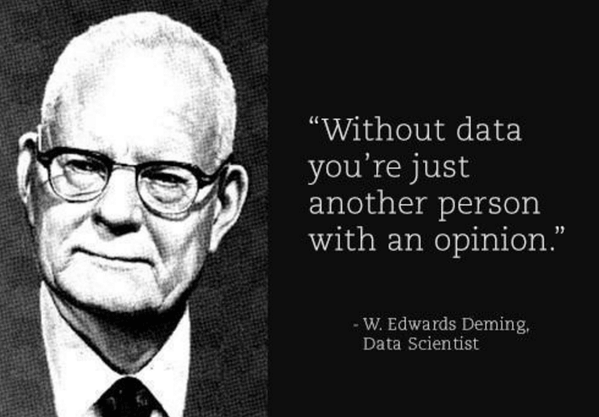In my last post, we talked about why a data-driven culture is necessary and how companies can make the first steps toward developing such a culture. This week, I want to build on those thoughts and look at the desired outcome of a data-driven organization: data-driven decisions.
If you want a quick introduction to the attitudes driving the push for data-driven decision making, look no further than this video featuring LinkedIn’s Director of Data Science, Yael Garten. In the video, she speaks passionately about the data environment in the consumer space and why it is important for companies to move quickly in implementing data best-practices.
In the interest of supplementing these ideas, I intend to lay out a framework that shows how an organization can develop the trust in data that is requisite for data-driven decisions. We’re going to look at generating this trust from both the top-down and bottom-up, which is critical to these processes’ success.
Let’s get to it.
Don’t push an agenda, inspire one
If you’re familiar with the literature surrounding data-driven organizations, the fact that executive buy-in is one of the primary roadblocks to data-driven decision making will not come as a shock. But it is less clear how executives can show that they are serious about data. It all boils down to commitment, so here are some concrete ways that executives can show they are determined to be data-driven.
A good starting point is to implement metrics and reporting structures that make data reliance mandatory. You can’t pay lip service to being data-driven and expect management to voluntarily adjust processes with which they are comfortable and which have been successful in the past. There is individual risk involved with trusting your data, and people are not going to bear that risk without real incentives.
Designing MBOs that incorporate data analytics is a great way to show executive buy-in. It is a concrete demonstration that an organization is serious about fostering their internal reliance on data. Ideally, these MBOs will be linked to compensation. We want to reward managers for rigorously applying data best-practices to their employee and process management. If an organization can effectively incentivize data usage monetarily, it will see just how quickly people are capable of adapting to new processes.
But mandating buy-in is never going to be the most effective way of changing your company’s culture – especially if you experience setbacks during the early stages of the transition. You also need to measure and highlight individual “wins” that arise from your new data reliance.
This can be something as simple as:
- Here is how your time-to-market got shorter.
- Here is how your marketing numbers improved.
- Here is how merchandise sales increased.
The important thing is that you use data to show how data is improving your bottom line. Any successes arising from data-driven decisions need to be highlighted, and any failures need to be directly addressed.
Once managers and executives see how their bottom lines improve, they are going to have no choice but to trust the data coming from within the organization.
Data from the Bottom-Up
While getting executives and managers on board with data-driven decision-making is a challenge, the real difficulty an organization faces is in making sure data reliance is pervasive through a bottom-up approach.
Oftentimes, managers are asking employees to engage in processes that are decidedly NOT in their best interest. The transparency that data reliance offers is threatening to employees who feel they may be under performing or lack the confidence in their data literacy as it relates to competition with their peers.
Unfortunately, there is no panacea that will solve the problem of employee resistance to change. All we can do is to make sure that we incentivize good data practices and make engaging with data as efficient as possible. If there are roadblocks to accessing or utilizing data, they will contribute to a confirmation bias that data-driven decisions are more trouble than they’re worth.
The first thing we need to do from a bottom-up perspective is to make sure that our data collection processes are well defined. You need a solid infrastructure to collect the data, as well as metrics to monitor its usage, before you start asking employees to engage in the data-driven process.
Secondly, an organization needs to ensure data access. Does everyone have access to the data they need? Is it easy to get? When employees are empowered to use data to enhance their own decisions, they are going to be more amenable to applying data to the business process as a whole.
Finally, the data you are collecting needs to be usable. Standardized formats and a central repository for information can help familiarize your employees with the organization’s data process. Again, it is about injecting data-driven decisions throughout every level of organizational structure.
There is also an external factor that organizations have less control over in this context: career motivation. As data-driven decisions become the norm, it is in your employees’ best interest to be data literate and to be comfortable with having their performance tied nearly exclusively with data. Not just during their tenure with any particular organization, but throughout their career as a whole.
As data scientist W. Edwards Deming so eloquently said, “Without data, you’re just another person with an opinion.” When employees are recognized and valued for data-driven input, they are going to naturally favor data-driven decisions.
What all this Means
Throughout this post I have talked about four keystone aspects of ensuring an organization’s commitment to data-driven decisions:
- Executive Buy-In
- Clean collection
- Comprehensive access, and
- Easy usability
These four principles need to be addressed simultaneously. If executives aren’t rewarding good data practices, none of the data collection or usability matters. If you aren’t collecting clean data, who cares if it is accessible? If the data isn’t usable, why bother collecting it?
I mentioned earlier that it is important to trust your data; these practices are all designed to engender that trust. Decision making is the tip of an organization’s spear, and when you are using data to aim and hone that spear, it is critical that everyone has faith that their data foundation is solid. That’s why both top-down and bottom-up data reliance is necessary. All organization members need to be familiar with their data in order to trust it, thus the importance of easy collection, access, and usability.
But it takes time. In my last post, I talked about how transitioning to a data-driven organization is incremental in nature, and a large part of that is getting everyone in the organization to a baseline trust level with your data. That is part of the reason that in the video linked earlier in this post, Ms. Garten implores organizations to get started on their data-driven decision journey early. Because once that trust is established through the practices I have laid out above, data-driven decisions necessarily follow.













